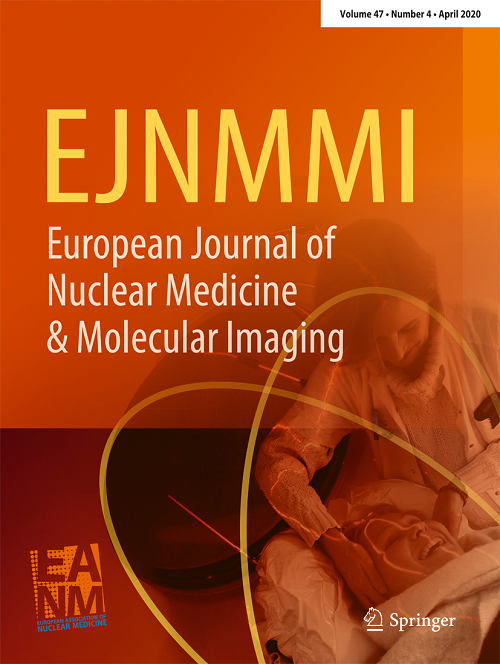Bone matters: Ga-68 PSMA PET/CT volumetrics predict PSA-PFS and OS in bone-dominant mCRPC patients treated with [¹⁷⁷Lu]Lu-PSMA-617.
IF 7.6
1区 医学
Q1 RADIOLOGY, NUCLEAR MEDICINE & MEDICAL IMAGING
European Journal of Nuclear Medicine and Molecular Imaging
Pub Date : 2025-09-29
DOI:10.1007/s00259-025-07556-w
引用次数: 0
Abstract
INTRODUCTION This study aimed to evaluate the prognostic value of baseline, interim, and change-based (Δ) volumetric parameters derived from PSMA PET/CT imaging in predicting PSA progression-free survival (PSA-PFS) and overall survival (OS) in bone-dominant metastatic castration-resistant prostate cancer (mCRPC) patients treated with [¹⁷⁷Lu]Lu-PSMA-617. METHODS This retrospective study included 56 bone-dominant mCRPC patients who underwent [⁶⁸Ga]Ga-PSMA PET/CT imaging before and after two cycles of [¹⁷⁷Lu]Lu-PSMA therapy. Quantitative parameters, including SUVmean, PSMA tumor volume (PSMA-TV), and total lesion PSMA activity (TL-PSMA), were extracted using a fixed threshold of SUV ≥ 3. Δ values were calculated as the relative change between baseline and interim scans. Associations with PSA-PFS and OS were analyzed using Cox regression and Kaplan-Meier survival analyses. RESULTS The presence of new lesions on interim PSMA PET/CT and a reduction of PSMA-TV(Bone) ≤ 10.7% were identified as independent predictors of shorter PSA-PFS (p = 0.022 and p = 0.043, respectively). For OS, an interim PSMA-TV(Bone) > 310.3 mL remained an independent prognostic factor both in the entire cohort (p < 0.001) and in the subgroup without early PSA progression (p = 0.002). While baseline SUVmean values were associated with PSA-PFS, no significant association with OS was observed. CONCLUSION In bone-dominant mCRPC patients treated with [¹⁷⁷Lu]Lu-PSMA, ΔPSMA-TV(Bone) ≤ 10.7% and the presence of new lesions were independent predictors of PSA-PFS, while interim bone tumor volume was significantly associated with OS. These findings highlight the clinical relevance of bone-specific volumetric parameters, which may serve as a potential alternative to whole-body tumor assessments by providing more practical and targeted prognostic insights in this patient population.骨问题:Ga-68 PSMA PET/CT体积测量可预测骨显性mCRPC患者接受Lu-PSMA-617治疗后的PSA-PFS和OS。
本研究旨在评估来自PSMA PET/CT成像的基线、中期和基于变化的(Δ)体积参数在预测骨优势转移性去势抵抗性前列腺癌(mCRPC)患者接受[¹⁷⁷Lu]Lu-PSMA-617治疗的PSA无进展生存期(PSA- pfs)和总生存期(OS)中的预后价值。方法本回顾性研究包括56例骨显性mCRPC患者,他们在[¹⁷⁷Lu]Lu- psma治疗前后接受了[⁶⁸Ga]Ga- psma PET/CT成像。采用SUV≥3的固定阈值提取定量参数,包括SUVmean、PSMA肿瘤体积(PSMA- tv)和病变总PSMA活性(TL-PSMA)。Δ值作为基线和中期扫描之间的相对变化来计算。采用Cox回归和Kaplan-Meier生存分析分析PSA-PFS和OS的相关性。结果PSMA中期PET/CT上出现新病灶和PSMA- tv (Bone)降低≤10.7%是缩短PSMA- pfs的独立预测因子(p = 0.022和p = 0.043)。对于OS,无论是在整个队列(p < 0.001)还是在没有早期PSA进展的亚组(p = 0.002)中,PSMA-TV(Bone)中期bb0 310.3 mL仍然是一个独立的预后因素。虽然基线suv平均值与PSA-PFS相关,但与OS无显著相关性。结论在骨显性mCRPC患者接受[¹⁷⁷Lu]Lu- psma治疗时,ΔPSMA-TV(Bone)≤10.7%和新病灶的存在是PSA-PFS的独立预测因子,而中期骨肿瘤体积与OS显著相关。这些发现强调了骨特异性体积参数的临床相关性,它可以作为全身肿瘤评估的潜在替代方案,为该患者群体提供更实用和有针对性的预后见解。
本文章由计算机程序翻译,如有差异,请以英文原文为准。
求助全文
约1分钟内获得全文
求助全文
来源期刊
CiteScore
15.60
自引率
9.90%
发文量
392
审稿时长
3 months
期刊介绍:
The European Journal of Nuclear Medicine and Molecular Imaging serves as a platform for the exchange of clinical and scientific information within nuclear medicine and related professions. It welcomes international submissions from professionals involved in the functional, metabolic, and molecular investigation of diseases. The journal's coverage spans physics, dosimetry, radiation biology, radiochemistry, and pharmacy, providing high-quality peer review by experts in the field. Known for highly cited and downloaded articles, it ensures global visibility for research work and is part of the EJNMMI journal family.

 求助内容:
求助内容: 应助结果提醒方式:
应助结果提醒方式:


